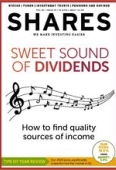Archived article
Please note that tax, investment, pension and ISA rules can change and the information and any views contained in this article may now be inaccurate.
The Creme Egg effect: ‘How do you pick your stocks?’

For years, Cadbury’s has tempted chocolate fans with its Creme Egg adverts asking, ‘how do you eat yours?’. While Shares readers may have enjoyed their fill of the gooey stuff at Easter, Cadbury’s marketing technique has led me to think about how investors find stocks for their portfolio.
‘How do you pick yours?’ is an interesting question for investors and one that can probably be put into six buckets: earnings momentum, ratings change, relative valuation, share price performance, director dealings and a good narrative for the company or its sector.
While this is by no means an exhaustive list, it does cover the key methods by which investors seek out ideas and do their research.
Just as there are many ways to eat a Creme Egg and still enjoy its sweet taste, the same applies with investing. There is not a right or wrong way to find an idea, it’s all about following a process that works for you.
Some investors are happy to screen the market for stocks trading on lower-than-average valuations, ones that have a history of delivering good returns, or simply jump on the bandwagon and buy shares that are already doing well.
Perhaps less effective is to look at changes in broker ratings. I’m more interested when an analyst does a double upgrade or downgrade which is to move from ‘sell’ to ‘buy’ or vice versa, skipping the ‘hold’ rating entirely, than a rating change up or down one level at a time.
Turning a rating on its head is a more powerful signal to sit up and take notice. However, like many broker calls, the success rate is mixed at best.
Last week we saw a double upgrade for Direct Line (DLG) after its share price was obliterated following profit warnings and dividend cancellations, with Citi now implying the motor insurance sector is past the worst following weaker policy pricing. While the shares jumped 6% when the research note was published, other recent examples suggest that double upgrades or downgrades should be taken with a pinch of salt.
Online furniture seller Wayfair (W:NYSE) got a double upgrade from JPMorgan in January, with the analyst saying they were previously negative on the stock in the belief market share gains during Covid were going to fade, earnings estimates were too high and that consumers would return to in-store shopping.
That was correct, but the analyst said more recently Wayfair had started to regain market share and was finding ways to slash costs. They also said the shares had sunk to below pre-Covid levels. The double upgrade caused the shares to soar, but the excitement has since fizzled away and the share price has lost all those broker upgrade-driven gains.
Tripadvisor (TRIP:NASDAQ) got a double upgrade from Bank of America in February, from ‘underperform’ to ‘buy’, which triggered a 5% rise in the share price on the day. After staying up for a week, the shares then went into a steady decline and are now trading 20% lower than the point of the double upgrade.
It’s tempting to eat three Creme Eggs in a row. Equally, it’s tempting to blindly follow a broker recommendation with investing. Don’t let greed cloud your judgment. Put temptation to one side and think hard about your decisions or you could regret it afterwards.
Important information:
These articles are provided by Shares magazine which is published by AJ Bell Media, a part of AJ Bell. Shares is not written by AJ Bell.
Shares is provided for your general information and use and is not a personal recommendation to invest. It is not intended to be relied upon by you in making or not making any investment decisions. The investments referred to in these articles will not be suitable for all investors. If in doubt please seek appropriate independent financial advice.
Investors acting on the information in these articles do so at their own risk and AJ Bell Media and its staff do not accept liability for losses suffered by investors as a result of their investment decisions.
Issue contents
Book reviews
Editor's View
Feature
Great Ideas
- Buy Empiric at a big discount to the other main player in student property
- Laboratory owner offers a cheap way into a growing specialist market
- Brunner: a great way to invest in stocks around the world on the cheap
- Rathbones raises its sights with £100 billion Investec wealth deal
- Our top picks for 2023 have made a superb start to the year

 magazine
magazine








